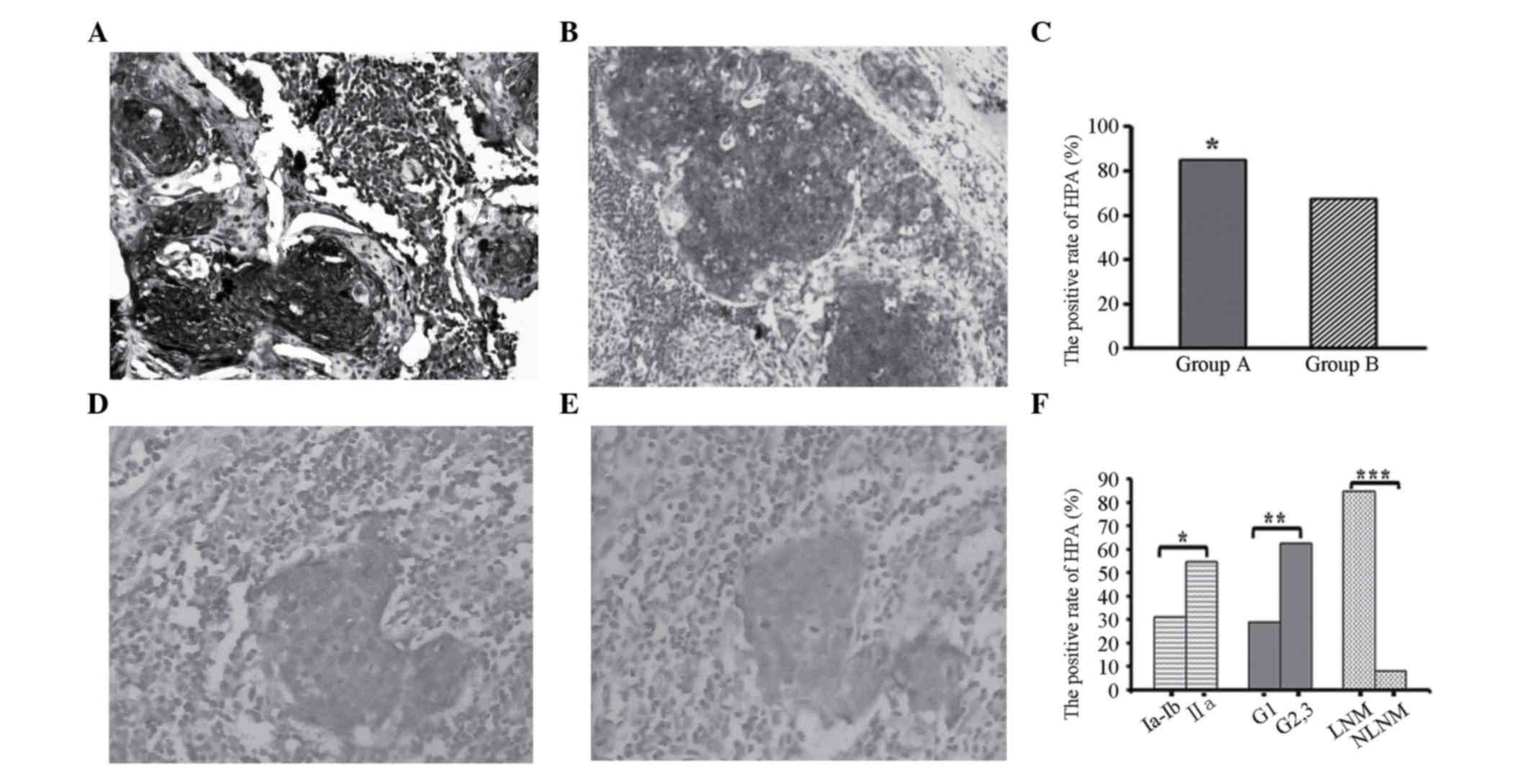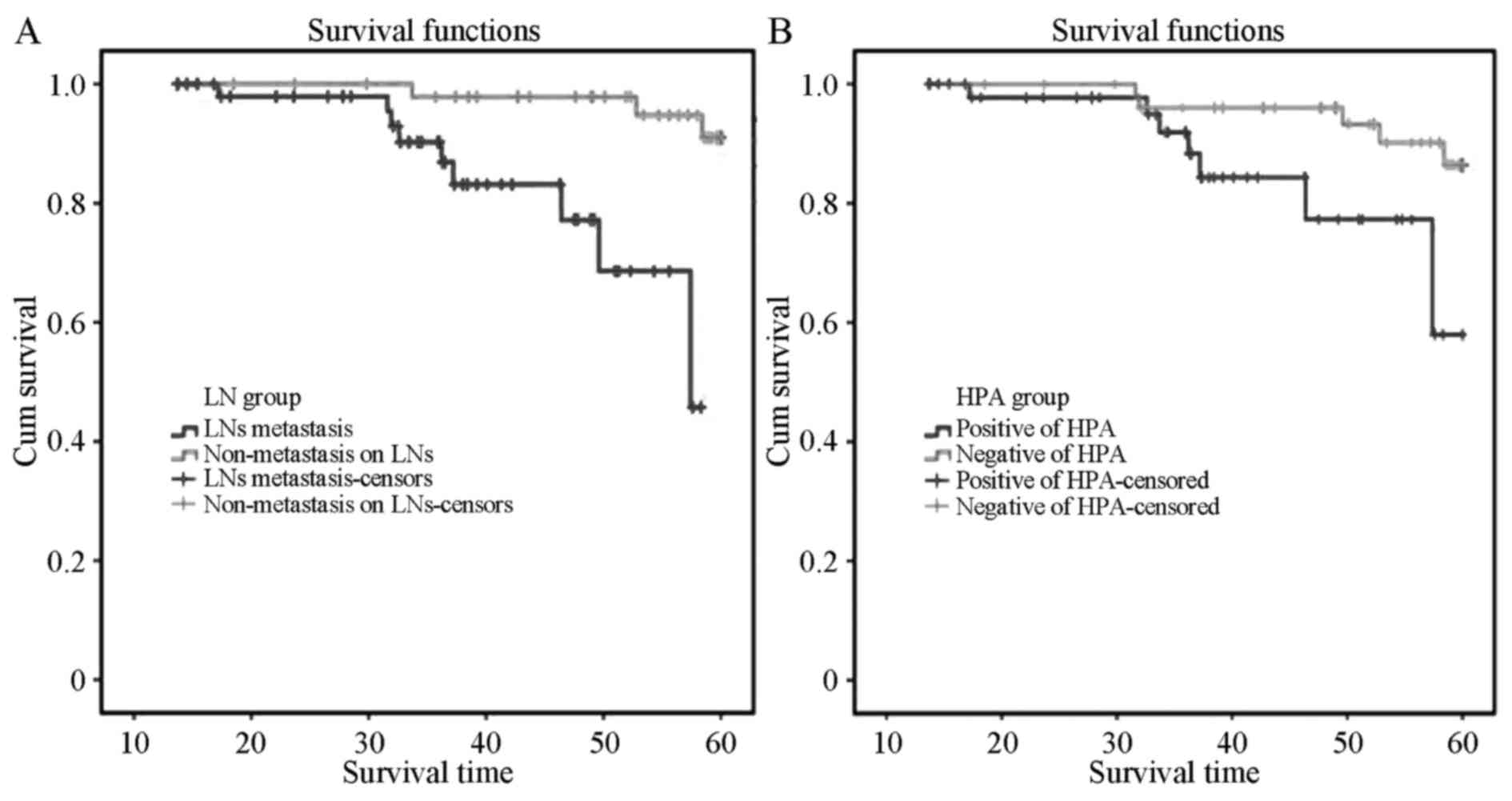|
1
|
Ho CM, Chien TY, Huang SH, Wu CJ, Shih BY
and Chang SC: Multivariate analysis of the prognostic factors and
outcomes in early cervical cancer patients undergoing radical
hysterectomy. Gynecol Oncol. 93:458–464. 2004. View Article : Google Scholar : PubMed/NCBI
|
|
2
|
Slama J, Dundr P, Dusek L and Cibula D:
High false negative rate of frozen section examination of sentinel
lymph nodes in patients with cervical cancer. Gynecol Oncol.
129:384–388. 2013. View Article : Google Scholar : PubMed/NCBI
|
|
3
|
Quinn MA, Benedet JL, Odicino F,
Maisonneuve P, Beller U, Creasman WT, Heintz AP, Ngan HY and
Pecorelli S: Carcinoma of the cervix uteri. FIGO 26th annual report
on the results of treatment in gynecological cancer. Int J Gynaecol
Obstet. 95:(Suppl 1). S43–S103. 2006. View Article : Google Scholar : PubMed/NCBI
|
|
4
|
Ditto A, Martinelli F, Lo Vullo S, Reato
C, Solima E, Carcangiu M, Haeusler E, Mariani L, Lorusso D and
Raspagliesi F: The role of lymphadenectomy in cervical cancer
patients: the significance of the number and the status of lymph
nodes removed in 526 cases treated in a single institution. Ann
Surg Oncol. 20:3948–3954. 2013. View Article : Google Scholar : PubMed/NCBI
|
|
5
|
Slama J, Fischerova D, Pinkavova I, Zikan
M and Cibula D: Human papillomavirus DNA presence in pelvic lymph
nodes in cervical cancer. Int J Gynecol Cancer. 20:126–132. 2010.
View Article : Google Scholar : PubMed/NCBI
|
|
6
|
Park JS, Namkoong SE, Han SK, Nha DJ, Lee
HY and Kim SJ: Comparison of L1 consensus primers with E6 type
specific primers for detection of human papillomaviruses in
paraffin sections of cervical neoplasia. J Korean Med Sci. 8:60–67.
1993. View Article : Google Scholar : PubMed/NCBI
|
|
7
|
Noventa M, Ancona E, Cosmi E, Saccardi C,
Litta P, D'Antona D, Nardelli GB and Gizzo S: Usefulness, methods
and rationale of lymph nodes HPV-DNA investigation in estimating
risk of early stage cervical cancer recurrence: a systematic
literature review. Clin Exp Metastasis. 31:853–867. 2014.
View Article : Google Scholar : PubMed/NCBI
|
|
8
|
Forman D, de Martel C, Lacey CJ,
Soerjomataram I, Lortet-Tieulent J, Bruni L, Vignat J, Ferlay J,
Bray F, Plummer M and Franceschi S: Global burden of human
papillomavirus and related diseases. Vaccine. 30:(Suppl 5).
F12–F23. 2012. View Article : Google Scholar : PubMed/NCBI
|
|
9
|
Tjalma WA, Van Waes TR, Van den Eeden LE
and Bogers JJ: Role of human papillomavirus in the carcinogenesis
of squamous cell carcinoma and adenocarcinoma of the cervix. Best
Pract Res Clin Obstet Gynaecol. 19:469–483. 2005. View Article : Google Scholar : PubMed/NCBI
|
|
10
|
Garland SM: Can cervical cancer be
eradicated by prophylactic HPV vaccination? Challenges to vaccine
implementation. Indian J Med Res. 130:311–321. 2009.PubMed/NCBI
|
|
11
|
Woodman CB, Collins SI and Young LS: The
natural history of cervical HPV infection: unresolved issues. Nat
Rev Cancer. 7:11–22. 2007. View
Article : Google Scholar : PubMed/NCBI
|
|
12
|
Hoste G, Vossaert K and Poppe WA: The
clinical role of HPV testing in primary and secondary cervical
cancer screening. Obstet Gynecol Int. 2013:6103732013.PubMed/NCBI
|
|
13
|
Hirshoren N, Bulvik R, Neuman T,
Rubinstein AM, Meirovitz A and Elkin M: Induction of heparanase by
HPV E6 oncogene in head and neck squamous cell carcinoma. J Cell
Mol Med. 18:181–186. 2014. View Article : Google Scholar : PubMed/NCBI
|
|
14
|
Baraz L, Haupt Y, Elkin M, Peretz T and
Vlodavsky I: Tumor suppressor p53 regulates heparanase gene
expression. Oncogene. 25:3939–3947. 2006. View Article : Google Scholar : PubMed/NCBI
|
|
15
|
Adams DH and Shaw S: Leucocyte-endothelial
interactions and regulation of leucocyte migration. Lancet.
343:831–836. 1994. View Article : Google Scholar : PubMed/NCBI
|
|
16
|
Blotnick S, Peoples GE, Freeman MR,
Eberlein TJ and Klagsbrun M: T lymphocytes synthesize and export
heparin-binding epidermal growth factor-like growth factor and
basic fibroblast growth factor, mitogens for vascular cells and
fibroblasts: differential production and release by CD4+ and CD8+ T
cells. Proc Natl Acad Sci USA. 91:2890–2894. 1994. View Article : Google Scholar : PubMed/NCBI
|
|
17
|
Vlodavsky I, Eldor A, Haimovitz-Friedman
A, Matzner Y, Ishai-Michaeli R, Lider O, Naparstek Y, Cohen IR and
Fuks Z: Expression of heparanase by platelets and circulating cells
of the immune system: possible involvement in diapedesis and
extravasation. Invasion Metastasis. 12:112–127. 1992.PubMed/NCBI
|
|
18
|
Pisano C, Vlodavsky I, Ilan N and Zunino
F: The potential of heparanase as a therapeutic target in cancer.
Biochem Pharmacol. 89:12–19. 2014. View Article : Google Scholar : PubMed/NCBI
|
|
19
|
Shinyo Y, Kodama J, Hongo A, Yoshinouchi M
and Hiramatsu Y: Heparanase expression is an independent prognostic
factor in patients with invasive cervical cancer. Ann Oncol.
14:1505–1510. 2003. View Article : Google Scholar : PubMed/NCBI
|
|
20
|
Zeng C, Ke ZF, Luo WR, Yao YH, Hu XR, Jie
W, Yin JB and Sun SJ: Heparanase overexpression participates in
tumor growth of cervical cancer in vitro and in vivo. Med Oncol.
30:4032013. View Article : Google Scholar : PubMed/NCBI
|
|
21
|
Prat J: FIGO Committee on Gynecologic
Oncology: Staging classification for cancer of the ovary, fallopian
tube, and peritoneum. Int J Gynaecol Obstet. 124:1–5. 2014.
View Article : Google Scholar : PubMed/NCBI
|
|
22
|
Kurman RJ, Carcangiu ML, Herrington CS and
Young RH: WHO Classification of Tumours of the Female Reproductive
OrgansWHO/IARC Classification of Tumours. 6. 4th. IARC; Lyon:
2014
|
|
23
|
Vlodavsky I, Elkin M and Ilan N: Impact of
heparanase and the tumor microenvironment on cancer metastasis and
angiogenesis: basic aspects and clinical applications. Rambam
Maimonides Med J. 2:e00192011. View Article : Google Scholar : PubMed/NCBI
|
|
24
|
Kim SH, Turnbull J and Guimond S:
Extracellular matrix and cell signalling: the dynamic cooperation
of integrin, proteoglycan and growth factor receptor. J Endocrinol.
209:139–151. 2011. View Article : Google Scholar : PubMed/NCBI
|
|
25
|
Barbouri D, Afratis N, Gialeli C, Vynios
DH, Theocharis AD and Karamanos NK: Syndecans as modulators and
potential pharmacological targets in cancer progression. Front
Oncol. 4:42014. View Article : Google Scholar : PubMed/NCBI
|
|
26
|
Hasengaowa Kodama J, Kusumoto T, Shinyo Y,
Seki N, Nakamura K, Hongo A and Hiramatsu Y: Loss of basement
membrane heparan sulfate expression is associated with tumor
progression in endometrial cancer. Eur J Gynaecol Oncol.
26:403–406. 2005.PubMed/NCBI
|
|
27
|
Kodama J, Shinyo Y, Hasengaowa Kusumoto T,
Seki N, Nakamura K, Hongo A and Hiramatsu Y: Loss of basement
membrane heparan sulfate expression is associated with pelvic lymph
node metastasis in invasive cervical cancer. Oncol Rep. 14:89–92.
2005.PubMed/NCBI
|
|
28
|
Ozasa R, Ohno J, Iwahashi T and Taniguchi
K: Tumor-induced lymphangiogenesis in cervical lymph nodes in oral
melanoma-bearing mice. J Exp Clin Cancer Res. 31:832012. View Article : Google Scholar : PubMed/NCBI
|
|
29
|
Biedka M, Makarewicz R, Marszałek A, Sir
J, Kardymowicz H and Goralewska A: Labeling of microvessel density,
lymphatic vessel density and potential role of proangiogenic and
lymphangiogenic factors as a predictive/prognostic factors after
radiotherapy in patients with cervical cancer. Eur J Gynaecol
Oncol. 33:399–405. 2012.PubMed/NCBI
|
|
30
|
Liu H, Xiao J, Yang Y, Liu Y, Ma R, Li Y,
Deng F and Zhang Y: COX-2 expression is correlated with VEGF-C,
lymphangiogenesis and lymph node metastasis in human cervical
cancer. Microvasc Res. 82:131–140. 2011. View Article : Google Scholar : PubMed/NCBI
|
|
31
|
Liu D, Li L, Zhang XX, Wan DY, Xi BX, Hu
Z, Ding WC, Zhu D, Wang XL, Wang W, et al: SIX1 promotes tumor
lymphangiogenesis by coordinating TGFβ signals that increase
expression of VEGF-C. Cancer Res. 74:5597–5607. 2014. View Article : Google Scholar : PubMed/NCBI
|
|
32
|
Cohen-Kaplan V, Naroditsky I, Zetser A,
Ilan N, Vlodavsky I and Doweck I: Heparanase induces VEGF C and
facilitates tumor lymphangiogenesis. Int J Cancer. 123:2566–2573.
2008. View Article : Google Scholar : PubMed/NCBI
|
|
33
|
Dafni H, Cohen B, Ziv K, Israely T,
Goldshmidt O, Nevo N, Harmelin A, Vlodavsky I and Neeman M: The
role of heparanase in lymph node metastatic dissemination: dynamic
contrast-enhanced MRI of Eb lymphoma in mice. Neoplasia. 7:224–233.
2005. View Article : Google Scholar : PubMed/NCBI
|
|
34
|
Wang HY, Sun JM, Lu HF, Shi DR, Ou ZL, Ren
YL and Fu SQ: Micrometastases detected by cytokeratin 19 expression
in sentinel lymph nodes of patients with early-stage cervical
cancer. Int J Gynecol Cancer. 16:643–648. 2006. View Article : Google Scholar : PubMed/NCBI
|
|
35
|
Nagai T, Niikura H, Okamoto S, Nakabayashi
K, Matoda M, Utsunomiya H, Nagase S, Watanabe M, Takeshima N and
Yaegashi N: A new diagnostic method for rapid detection of lymph
node metastases using a one-step nucleic acid amplification (OSNA)
assay in endometrial cancer. Ann Surg Oncol. 22:980–986. 2015.
View Article : Google Scholar : PubMed/NCBI
|











